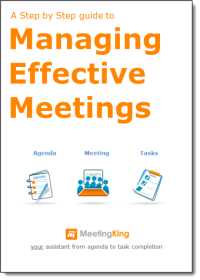Virtual meetings are more and more frequently becoming standard day-to-day business practice, and businesses need to understand how to run remote meetings effectively. However, running an in-person meeting is still far more frequent of an occurrence in organizations, and many can benefit from learning how to increase effectiveness in this area.
Every meeting can benefit from an agenda. An agenda adds structure to a meeting, and lets participants know what subject matters are to be covered. It allows participants to think through their views on different subjects ahead of the meeting, and to be prepared for them. During an in-person meeting, it is easier to keep on-subject when a paper, or on-screen agenda can be referred back to. Preparing and updating an agenda is often ignored because it is a time consuming activity if you use the traditional combination of email and Word. MeetingKing makes it easy – participants can add topics and attachments to the agenda, you can change the sequence of topics, tasks from previous meeting are automatically added to the agenda and you can email the agenda with one click.
Back to in-person meetings; body language is one huge benefit of holding in-person meetings. It is much easier to gauge exactly what a person thinks or feels about any particular issue if they are face-to-face, rather than online. For example, leaning forward and making eye contact usually indicates that a participant is interested in or passionate about a particular subject, whereas leaning back, arms folded and with a distant look on a person’s face may mean that a person is either not engaged, or is outright hostile towards an opinion or a subject area. Learning about what different classic body language means can be of great assistance in running an in-person meeting effectively as it helps the organizer to pick up on those more subtle hints about what is going on with particular individuals or groups.
Being organized is an essential part of running an in-person meeting effectively. It can be very frustrating for meeting attendees to wait around for a meeting organizer who is trying to find the right page in a document to refer to, or who is spending precious meeting time trying to get the projector to work properly. MeetingKing allows all meeting documentation referred to within a meeting to be stored in one place, meaning that attendees can all have access to it easily. This facilitates a more effective preparation and running of meetings. This allows both meeting organizers and meeting participants to be better organized about meetings.
Where in-person meetings are to be held at meal times, such as at breakfast or during lunch hours (between midday and 2pm) it may be useful for the meeting organizer to advise if refreshments will be provided at the meeting or not. If not, this allows participants to be prepared in advance by choosing to eat beforehand if need be.
Task management is essential to any meeting. Minutes should be taken and actions assigned. In-person meetings can be improved in effectiveness by using a tool such as MeetingKing to help coordinate and manage such tasks. If nobody keeps minutes, and no tasks are written down, it is all too easy for participants to afterwards claim that they do not remember agreeing to a task. With MeetingKing, very simple notes can be made during the meeting, and tasks assigned on the spot and after the meeting you can automatically email nicely formatted minutes and automatic task reminders without any additional work.
It is clear that good, well-run in-person meetings require good tools to support them. MeetingKing serves as just the tool to add the kind of structure needed to in-person meetings to make them effective.


